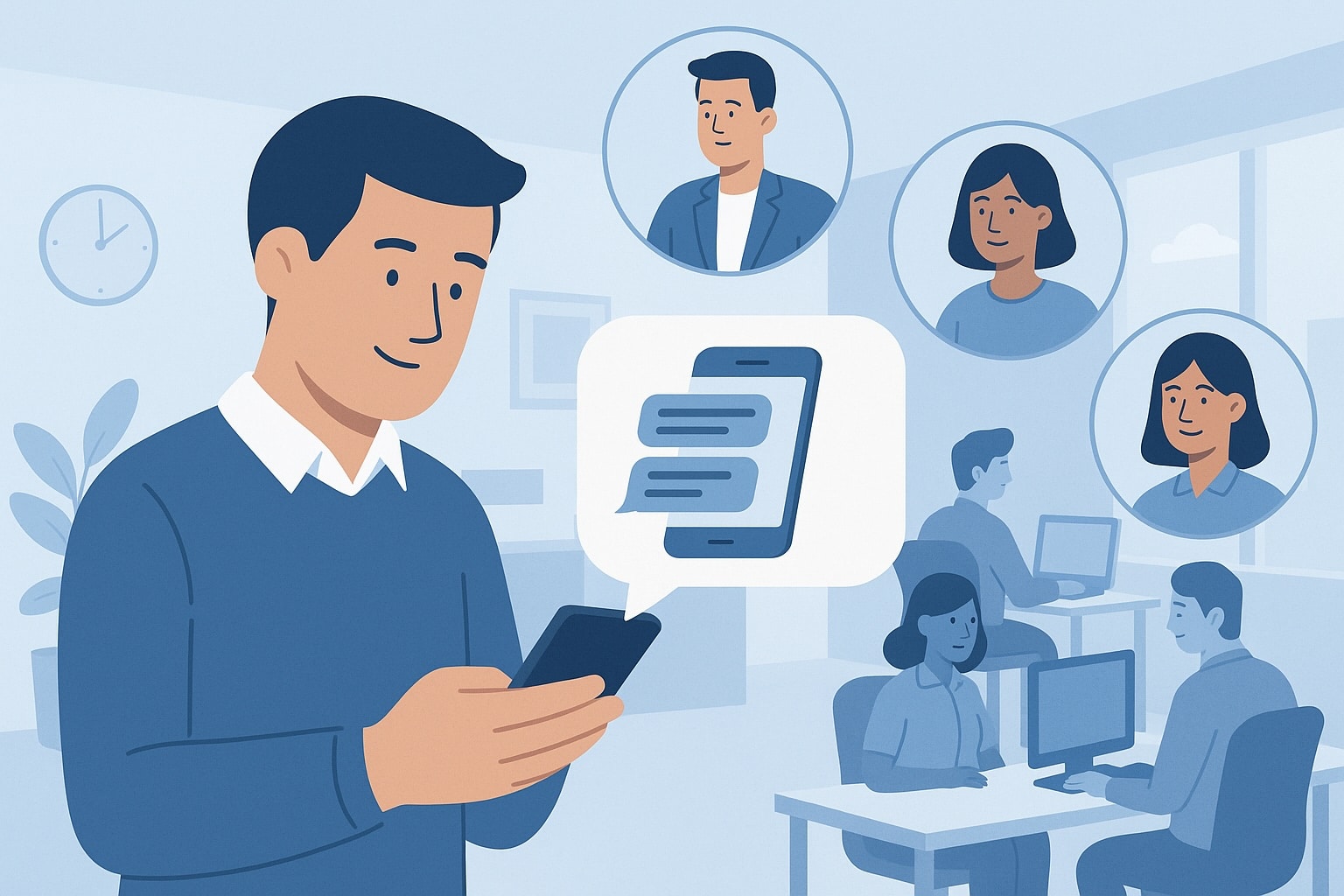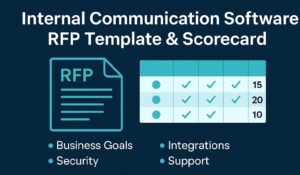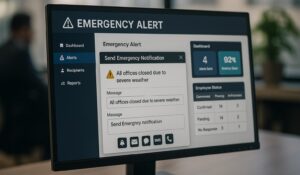Using text messages to communicate with employees is one of the most effective ways to ensure updates are delivered quickly and reliably. Whether it’s a short work text, a team text for coordination, or a mass text employees alert, these work-related text messages help organizations connect with staff instantly. This approach is especially valuable for frontline and deskless employees who may not check email regularly, ensuring important updates are never missed.
Employees today are overwhelmed with information. Between overflowing inboxes, chat notifications, and countless workplace apps, it’s easy for critical updates to get lost. For organizations trying to reach every worker—from desk-based teams to those on the frontline—the challenge is even bigger.
That’s where text messaging communication comes in. By leveraging focused text staff messages, organizations can cut through the noise. SMS is fast, personal, and nearly universal. In this guide, we’ll explore why work-related text messages are such an effective tool for alignment, how to implement them, and best practices to maximize engagement.
Key Takeaways
- 98% of U.S. adults own a cellphone and 91% own a smartphone (Pew Research Center). Nearly every employee can be reached via SMS.
- SMS messages are read within minutes, making them far more effective for urgent updates than email (CTIA).
- SMS is ideal for deskless, remote, and frontline workers who may not check email or intranets regularly.
- Use cases include shift reminders, HR updates, emergency alerts, recognition, and quick surveys.
- SMS works best as part of a multi-channel strategy alongside intranets, email campaigns, chat, and digital signage.
Advantages of Using Text Messages to Communicate with Employees
Text messaging offers a range of clear advantages for internal communication, making it one of the most effective ways to reach every employee quickly and reliably:
- Speed and Immediacy: Messages are typically read within minutes, ensuring time‑sensitive information is received when it matters most.
- Universal Accessibility: With nearly all adults owning a mobile phone, SMS guarantees broad coverage across desk‑based, remote, and frontline staff.
- Simplicity and Familiarity: Employees don’t need to learn a new tool—sending a work text or text staff message is already part of their daily routine.
- High Engagement: Compared with email, work-related text messages achieve significantly higher open and response rates, increasing the likelihood of action.
- Inclusivity: Ideal for deskless and shift workers who may not have regular access to email or intranets.
- Two‑Way Communication: Beyond announcements, SMS allows for quick confirmations, polls, and feedback. A team text can streamline group coordination instantly.
- Mass Communication: The ability to mass text employees ensures urgent messages reach everyone at once.
- Cost‑Effective: Platforms consolidate communication without adding more apps to employees’ workload.
Together, these advantages make text messaging communication a strategic channel for improving communication equity, boosting engagement, and supporting operational efficiency.
Why SMS Works for Internal Communication
While the advantages highlight the broad benefits of SMS, it’s important to understand the underlying reasons it performs so well:
- Near-universal reach: 98% of U.S. adults own a cellphone, and 91% own a smartphone (Pew Research Center).
- High engagement supported by data: SMS has extremely high engagement, with most messages read within minutes (CTIA). By comparison, Mailchimp benchmarks show average email open rates across industries hover around 34%.
- Accessibility for non-desk employees: Frontline staff, field technicians, and shift-based employees aren’t always near email or intranets. SMS keeps them connected.
- Reliability in emergencies: From safety alerts to office closures, SMS ensures time-sensitive information gets noticed immediately.
- Proven boost to participation: Quick polls and surveys via text staff messages or team text can generate significantly higher response rates than traditional survey emails.
High-Value Use Cases for Employee SMS
Text messaging can improve nearly every aspect of internal communications. Here are the most impactful ways organizations use it, with examples:
Announcements & Reminders
- Policy updates and compliance deadlines
- Meeting or event reminders
- Company news and achievements
Example: A retail chain sends a work text reminding employees of a new in-store promotion starting that day.
Scheduling & Shift Coverage
- Shift reminders and open shift notifications
- Confirmations of schedule changes
- Coverage requests for last-minute gaps
👉 See our Internal SMS guide for deeper scheduling strategies.
Example: A hospital sends a team text to all qualified nurses when an open shift becomes available, filling coverage within minutes.
HR Workflows
- Onboarding updates and paperwork reminders
- Benefits enrollment deadlines
- Recognition messages and morale boosts
👉 Explore our SMS for HR article for detailed use cases.
Emergency & Safety Alerts
- Weather or facility closures
- Health and safety warnings
- Security notifications
👉 Check our Crisis Communication Toolkit for more resources.
Example: A logistics company uses mass text employees functionality to alert drivers about a highway closure and reroute them instantly.
Surveys & Feedback Loops
- Quick polls (“Reply 1 for Yes, 2 for No”)
- Engagement pulse checks
- Post-event or training feedback
Recognition & Culture
- Birthday and anniversary shout-outs
- Team wins and milestone celebrations
- Motivational weekly kickoffs from leadership
Example: A manager sends a work-related text message thanking employees after a successful product launch, boosting morale.
Best Practices for SMS Employee Communication
- Keep it short and actionable. Limit messages to what employees need to know now. Link to longer resources if needed.
- Personalize where possible. Use names, roles, or location-specific details.
- Leverage two-way messaging. Encourage confirmations, polls, and quick responses through team text messages.
- Respect timing. Avoid after-hours texts unless urgent. For example, send shift reminders the evening before or policy updates early in the workweek.
- Don’t overuse SMS. Save it for need-to-know or time-sensitive information.
- Use mass text employees thoughtfully. Save mass updates for urgent or organization-wide messages.
- Combine channels. Use SMS for immediacy, email campaigns for detail, and intranets for permanence.
- Track outcomes. Measure not just sends but the impact on engagement and operations.
Key Metrics & ROI of Employee SMS
Organizations using SMS for internal communication often see measurable improvements:
- Shift coverage rates: Filling open shifts faster by 30–50% (SHRM).
- Emergency acknowledgement times: Reducing average response time from hours to minutes with mass text employees functionality.
- Survey participation: Increasing response rates by 20–40% compared to email-only surveys (Gallup).
- Engagement scores: Higher morale and recognition scores when SMS is used for timely shout-outs.
- Cost savings: Less reliance on overtime or agency staff by improving communication efficiency.
Including these metrics in reporting helps demonstrate ROI to leadership and secures long-term adoption.
SMS-Only Tools vs. Multi-Channel Platforms: A Comparison
| Feature/Capability | SMS-Only Tools (e.g., Textline, SimpleTexting) | Multi-Channel Platforms (e.g., HubEngage) |
|---|---|---|
| One-to-many messaging | ✔️ | ✔️ |
| Two-way messaging | ✔️ (basic) | ✔️ (with advanced workflows) |
| Segmentation | Limited | Robust (role, location, department) |
| Templates & automation | Basic | Advanced, multi-channel |
| Analytics & reporting | Delivery/read rates only | Engagement KPIs + ROI insights |
| HRIS & system integrations | Few | Extensive (HRIS, payroll, intranet, LMS) |
| Multi-channel communication | ❌ | ✔️ (SMS, email, intranet, chat, signage) |
| Compliance & audit trails | Limited | Full governance, opt-in tracking |
| Employee engagement features | ❌ | ✔️ (recognition, surveys, gamification) |
| Scalability | Designed for small use cases | Flexible for SMBs and enterprises |
👉 HubEngage Texting Platform delivers more than just SMS—integrating text messaging into a unified, multi-channel employee communication and engagement platform. See our full guide on Best Text Messaging Service for Business.
Ready-to-Use SMS Templates
Here are examples you can adapt and use immediately across different scenarios:
Announcements & Reminders
- “Reminder: Benefits enrollment closes Friday. Log in to the portal today to complete your selections.”
- “Company Town Hall tomorrow at 2 PM in Conference Room A. Join via Zoom if remote.”
Scheduling & Shift Coverage
- “Hi Alex, you’re scheduled for a shift tomorrow at 9 AM. Please reply YES to confirm.”
- “Open shift available tonight 6–10 PM. Reply CLAIM if interested.”
HR & Onboarding
- “Welcome aboard, Jordan! Please complete your onboarding forms before your first day. Check your email for details.”
- “Reminder: Expense reports for September are due Friday. Submit via the HR portal.”
Emergency & Safety Alerts
- “Weather alert: Office closed tomorrow due to snowstorm. Work remotely. Stay safe!”
- “Building B lockdown in effect. Please stay in your current location until all clear.”
Surveys & Feedback
- “Quick poll: Did you find yesterday’s training useful? Reply 1 = Yes, 2 = No.”
- “How was your week? Reply GOOD, OK, or NEED HELP.”
Recognition & Culture
- “Happy Work Anniversary, Priya! Thank you for 5 amazing years with our team 🎉.”
- “Congrats to the Sales Team for exceeding targets this quarter! Free lunch on Friday!”
👉 These templates save time, set clear expectations, and make communication consistent.
Compliance, Privacy & Governance
Employee texting is powerful, but it requires careful handling.
- Consent matters. In the U.S., laws like TCPA require clear opt-in before texting employees. In the EU, GDPR requires freely-given, specific, informed consent.
- Data protection. Avoid sharing highly sensitive or confidential data over SMS.
- Quiet hours. Establish boundaries around when texts can be sent.
- Audit trails. Use platforms that log all communication for accountability.
The Future of Employee Text Messaging
SMS is evolving beyond basic one-way alerts:
- AI personalization. Intelligent systems can tailor timing, tone, and content based on employee behavior.
- Multi-channel orchestration. Platforms like HubEngage integrate SMS with email, intranet, chat, and signage.
- Advanced analytics. Beyond open rates, measure how SMS drives attendance, reduces turnover, or accelerates compliance.
- Emerging tech: RCS (Rich Communication Services) and WhatsApp for Business are growing alternatives that may merge with enterprise comms strategies.
- Industry forecasts: Analysts predict continued adoption of mobile-first tools as more organizations embrace hybrid and deskless workforces (Gartner).
Conclusion
Text messaging is one of the fastest, most reliable ways to reach employees—whether they’re at a desk, on the frontline, or working remotely. From reminders to emergency alerts to morale boosts, SMS can unify your workforce and ensure no message goes unseen.
By using a mix of work text, team text, and the ability to mass text employees, organizations can simplify communication, boost engagement, and create a stronger workplace culture. As more companies adopt digital tools, using text messages to communicate with employees will remain a core strategy for effective, equitable communication.
Key Points to Remember
- SMS offers unmatched speed, accessibility, and engagement.
- Use cases span HR, operations, emergency alerts, recognition, and culture.
- Best practices include brevity, personalization, timing, and compliance.
- Measurable ROI includes faster shift coverage, higher survey responses, and improved engagement.
FAQs
What are the advantages of using text messages to communicate with employees?
The biggest advantages include speed, reliability, and inclusivity. Using text messages to communicate with employees ensures messages are delivered instantly and read quickly, even by deskless or frontline workers.
How can team text improve collaboration at work?
A team text allows managers to reach an entire group instantly with updates, reminders, or urgent alerts. It creates a simple way to coordinate shifts, share announcements, and keep everyone aligned without relying on email or apps.
What is a work text and how is it different from personal texting?
A work text is a professional message sent from an organization to employees for business purposes—such as reminders, shift updates, or compliance notices. Unlike personal texting, work texts are governed by policies, compliance rules, and best practices for professional communication.
How does mass text to employees help in urgent communication?
Mass text employees functionality lets organizations send one message to hundreds or thousands of staff members at once. This is especially effective for emergency alerts, office closures, or time-sensitive updates where speed matters.
What are best practices for sending work-related text messages?
When sending work-related text messages keep them short, clear, and actionable. Respect quiet hours, avoid overuse, and ensure the content is relevant. For longer details, include a link to intranet or email.
How can text messaging communication support deskless staff?
Text messaging communication ensures employees without regular computer access still receive important information. From shift confirmations to safety alerts, it provides an equitable way to connect deskless staff to company updates.













